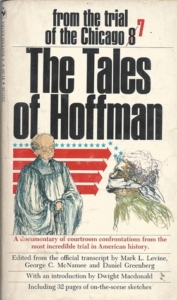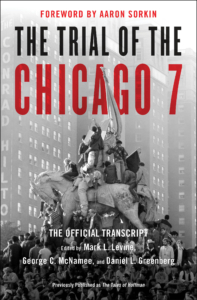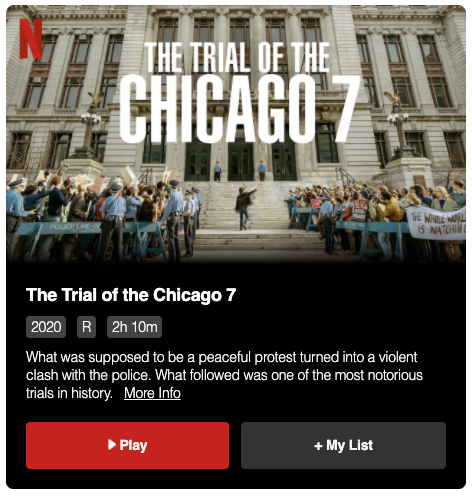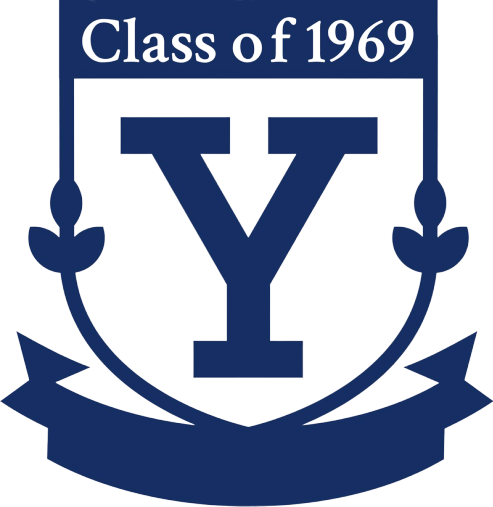My 1970 book is re-released as Aaron Sorkin movie premieres
 Today, Friday, October 16th, The Trial of the Chicago 7 premieres on Netflix. Written and directed by Aaron Sorkin, it is a powerful movie that captures the emotion and excitement of being alive in 1969. That was our time.
Today, Friday, October 16th, The Trial of the Chicago 7 premieres on Netflix. Written and directed by Aaron Sorkin, it is a powerful movie that captures the emotion and excitement of being alive in 1969. That was our time.
Fifty years ago, two of my movement friends and I produced the Tales of Hoffman which became the definitive edition of the transcript of the trial.
In 1970, The New York Times wrote that our book was “a sometimes hilarious, often disturbing and always engrossing slice of documentary history.” This year, Simon and Schuster re-released it, renaming it The Trial of the Chicago 7. Aaron Sorkin has written an introduction to the new edition.
 Sorkin also created a screenplay from the book; Steven Spielberg’s Dreamworks and Netflix developed it into a film; and it was released today, quickly appearing on the “trending on Netflix” list owing to its strong early reception.
Sorkin also created a screenplay from the book; Steven Spielberg’s Dreamworks and Netflix developed it into a film; and it was released today, quickly appearing on the “trending on Netflix” list owing to its strong early reception.
This is the story of a rogue president who preaches law and order, sows racial division, encourages the police to use violence against peaceful protestors, and is deaf to cries for justice from a broad national movement. Imagine that this President finds a subservient Attorney General willing to use the Justice Department for his political purposes.
The President, of course, is Richard Nixon. His enemies include the peace movement. He wants their leaders indicted and Attorney General John Mitchell is happy to oblige. The result was the show trial of the century, the Trial of the Chicago 7. The trial transcript is theatre of the absurd from the very first day of the trial.
The Prosecutor: “The Defendants Dellinger, Davis and Hayden joined with five other defendants who are charged in this case in their venture to succeed in their plans to create riots in Chicago during the time the Democratic National Convention was convened here. Two of these defendants, the Defendant Abbie Hoffman who sits — who is standing for you, ladies and gentlemen —”
Judge: “The jury is directed to disregard the kiss thrown by the Defendant Hoffman and the defendant is directed not to do that sort of thing again.” (Trial of the Chicago 7, page 4)
 It had to be absurd because it was a conspiracy trial where the government invented the conspiracy. They handpicked the defendants to be representative of the broad currents of the peace movement. Their point was that they could indict any of us. As defendants, they chose pacifist David Dellinger (Yale, 1936), Abbie Hoffman and Jerry Rubin of the Woodstock generation, Tom Hayden and Rennie Davis of Students for a Democratic Society, Bobby Seale, the Chairman of the Panther Party, and the randomly selected John Froines and Lee Weiner.
It had to be absurd because it was a conspiracy trial where the government invented the conspiracy. They handpicked the defendants to be representative of the broad currents of the peace movement. Their point was that they could indict any of us. As defendants, they chose pacifist David Dellinger (Yale, 1936), Abbie Hoffman and Jerry Rubin of the Woodstock generation, Tom Hayden and Rennie Davis of Students for a Democratic Society, Bobby Seale, the Chairman of the Panther Party, and the randomly selected John Froines and Lee Weiner.
Mayor Daley wanted to shift the blame for the riots from the Chicago P.D. to the protestors, and Nixon wanted to equate all protest with rioting and all protestors with criminals. With Daley’s former law partner Julius Hoffman presiding over the trial, convictions were inevitable. The defense responded by trying to put the government on trial. The result was a circus.
Abbie Hoffman: “Wait until you see the movie.”
Judge: “And you be quiet.”
Abbie Hoffman: “Well—the movie’s going to be better.” (page 177)
The book is pretty good too.
- The Atlantic magazine said today: “Our writers examined Netflix’s The Trial of the Chicago 7 (a new Aaron Sorkin movie that’s perfect for this moment) ….”
- This story in The Guardian says that the film is Oscar-bound, too.
- See also, The New Yorker, Aaron Sorkin Puts America on Trial


There’s another connection to our class: I had John Froines, who was a Yale Chemistry Grad Student, in 1965 as a lab instructor in freshman Chemistry.
John is probably the least known of the Chicago 7. I liked John a lot because he showed this rather button-downed college freshman how to live a little on the wilder side. Although accused and tried as one of the Chicago 7, he was acquitted. He used the education he received at Yale in earning his Ph.D. to work in advocating for protecting the environment from toxic chemicals.
Harry, that is a valuable nugget of information, and history, his and yours.
How did he get implicated and involved in the Seven?
Most curious.
Art, I don’t know for sure, but I do know that even while at Yale he was very active in the anti-Vietnam War movement. It turns out that he was charged with interstate travel for purposes of inciting a riot and with making incendiary devices. Although acquitted, the label of being part of the Chicago 7, along with his continued activism as an environmentalist, seems to have followed him in the minds of conservative Californians.
In 2010, there was controversy surrounding the makeup of the California Scientific Review Panel on Toxic Air Contaminants of which Froines was chair. These objections were brought up by conservatives who seem to have had it in for Froines because of his 40-year ago involvement as one of the Chicago 7.
This latest film is not the only one about this event. In 2013 there was another one, titled The Chicago 8 (I recall, but don’t remember the details of 7 vs 8), that was made for cable drama about the trial of the Chicago 7.
There is a short article in Wikipedia about Froines at https://en.wikipedia.org/wiki/John_Froines
That’s it from the way-back desk…
Frends,
I watched the Chicago 7 movie with great interest since I had been at the 1968 convention a few weeks before our senior year and attended a session of the 1969 trial over my winter break from medical school. The movie captured the mood of the times well. I can’t resist a few clarifications and additions.
The presence of German Shepard police dogs and barbed wire in front of the Hilton was surreal for a Chicago native.
Tear glass was released in Grant Park to disperse the demonstrators. The wind shifted and the tear gas filled the lobby of the Hilton. Delegates and others (including me) were trapped until they could get an elevator to another floor.
On the last night of the convention, the crowd of protestors in front of the Hilton chanted “the Whole World is Watching” for several hours. The sound carried remarkably well to the 20th floor Humphrey headquarters where I was working. Jubilant Hubert Humphrey pretended to not hear it. (Years later, the top floor of the Hilton would be featured in the climactic chase scene of The Fugitive movie).
Mayor Daley uttered a memorable malapropism; “Gentlemen, get the thing straight once and for all – the policeman isn’t there to create disorder; the policeman is there to preserve disorder.”
Fred Hampton, the murdered Black Panther leader was from the town of Maywood, Illinois where our university medical center is located. The police fired ninety-nine bullets into Fred Hampton and Mark Clark who were both asleep. One shot was fired by either Hampton or Clark. A street in Maywood and an aquatic center bear his name today.
The Dirksen Federal Building, where the trial took place was an ultra-modern 1964 Ludwig Mies van der Rohe glass and steel structure, unlike the classic courtroom set in the movie.
The defense subpoenaed Mayor Richard J Daley to testify in December 1969. The occasion was irresistible. My sister and I camped out overnight in sleeping bags to assure that we would be able to get one of the few spectator seats. We gained admission to court but were disappointed that at the last moment, Daley’s court appearance was continued a few days. We were lucky that we were in the courtroom for Abbie Hoffman’s testimony – Sacha Baron Cohen captured Abbie Hoffman’s irreverent spirit remarkably well in the film.
The real Judge Julius Hoffman was much less vigorous than Frank Langella who portrayed him in the film. Judge Hoffman often fell asleep on the bench after lunch.
From time to time, Attorney Kunstler would ask permission to confer with his clients. Once permission was granted, the seven defendants and their lawyer would link arms and form a football-style huddle in the front of the room. As their discussion concluded, all would break the huddle and clap their hands loud enough to wake the judge. Terrific theater.
Terry R. Light, M.D.
Professor, Department of Orthopaedic Surgery and Rehabilitation
Loyola University Stritch School of Medicine
2160 South First Avenue
Maywood, IL. 60153
Phone: 708-216-4570
e-mail: tlight@lumc.edu
George, the book is awesome, as is the film. Congratulations for creating the one, and inspiring the other. Why did it take fifty years?